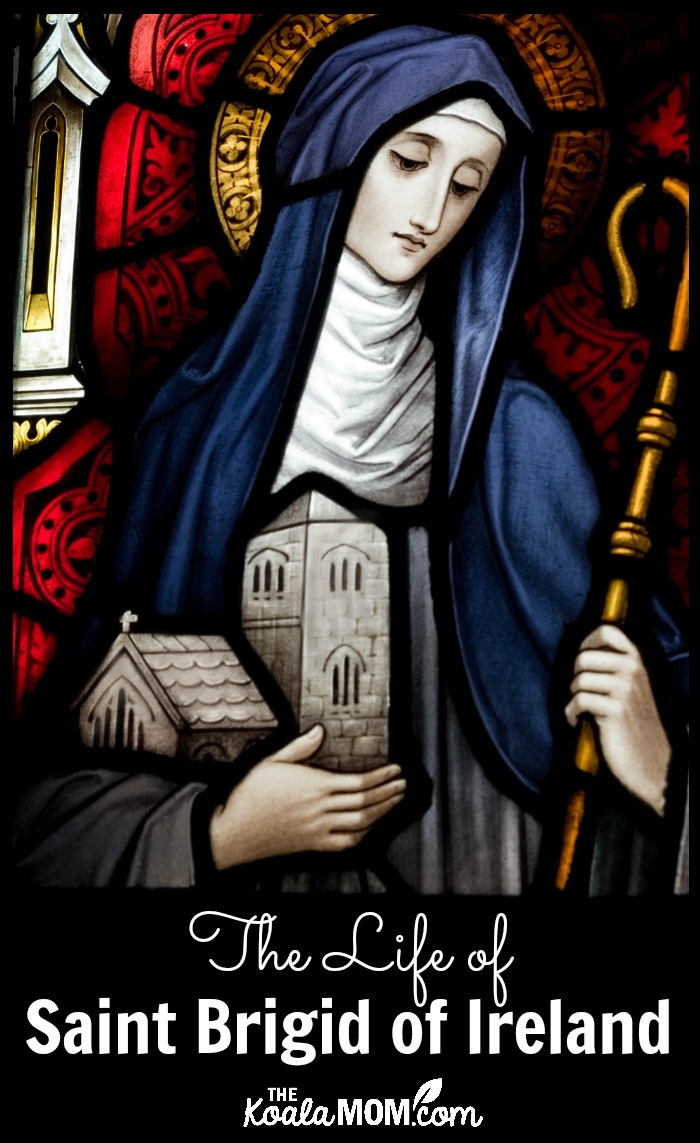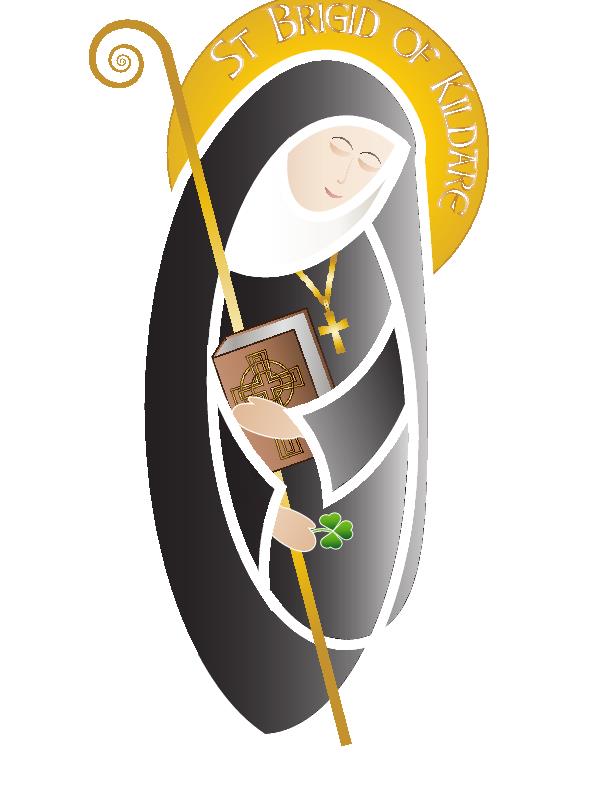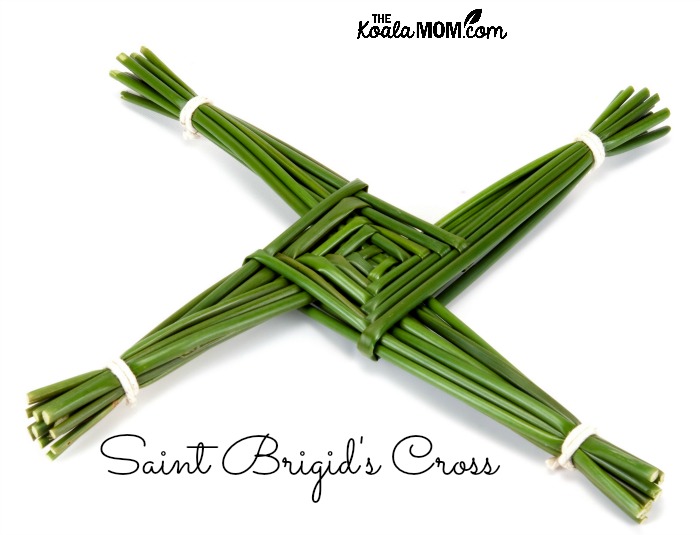February 1st is the feast day of Saint Brigid of Kildare (or Ireland). I first discovered this saint when we were looking for names for Lily. Because she is the patron saint of midwives, I asked for her intercession during the last stressful months of my pregnancy.
Since then, I’ve been learning more about this fascinating woman, also known as Brigit, Bridget, or Bride and Mary of the Gael. She lived in Ireland during the fifth century. While it’s hard to find much information about her life, it is clear that she was a holy woman who had a great impact upon the country of her day.

This post contains affiliate links; as an Amazon associate, I earn from qualifying purchases.
Saint Brigid’s Childhood
Brigid was born in about 450 in Ireland. Her father was an Irish chieftain or king and her mother was a slave in his court. She was most likely born out of wedlock, but later her father claimed her and raised her with his other children. Her parents may have been baptized by Saint Patrick and she herself likely heard the great saint preach. She was interested in the religious life from a young age.
Brigid likely worked in her mother’s dairy, which prospered under her hand, despite the fact that she gave much of its produce away. She was known as a generous, kind-hearted girl who tried to help anyone in need.
Brigid was nothing if not hospitable. It’s said she turned a barrel of beer into enough for eighteen churches; as a child, she gave away butter to the poor and turned water into healing milk. ~ Melanie Rigney, Sisterhood of Saints
St. Brigdet’s Life as a Nun and Abbess
She became a nun as a young woman and lived for a time with seven other young nuns at the foot of Croghan Hill. Later, she moved to Meath. In 470 she founded a double-monastery (for both men and women) at Kildare (from Cill-Dara or “church of the oak” because it was located under an oak tree).
Because a priest was necessary to ordain the monks and priests, Brigid appointed St. Conleth as the first Bishop of Kildare. Together, he and Brigid led the nuns and monks and for many years this tradition of an abbess and bishop continued at Kildare. In The Big Book of Women Saints, Sarah Gallick notes that Brigid was aided by her faithful cook Flora in welcoming pilgrims to the abbey.
“Christ is in the person of every faithful guest.” ~ St. Brigid
At Kildare, Brigid also established a school of art that became famous for its illuminated manuscripts, in particular the Book of Kildare which has unfortunately been lost.
She was known for her travel around Ireland, preaching and healing. Her early biographers described many miracles worked by Brigid’s prayers or intercessions, including blind and dumb children made well and lepers cured.
Brigid also is said to have been very bashful and modest. Yet she shared her gifts, time and knowledge freely with those in her monastery and beyond. She provides a good reminder to smile, engage, and trust the Holy Spirit when we are placed in unfamiliar social settings. ~ Sisterhood of Saints
Saint Brigid and Celtic Traditions
Some have suggested that the traditions associated with St. Brigid come from older traditions about Celtic deities. For example, St. Brigid’s feast day is also the day of the pagan festival of spring and Brighid was the name of a well-known pagan goddess. Oak trees were sacred to the Druids. In Ireland, Christianity melded itself with the traditions already present, rather than trying to destroy those traditions. A uniquely Celtic Christianity thus developed.
St. Brigid’s Cross
One popular story about Saint Brigid is how she went to visit a dying pagan chieftain. While she sat by his bed, she picked up some rushes from the floor and began fashioning them into a cross. The sick man asked what she was doing. She responded that she was making a cross in honour of Jesus, who died on a cross to save humankind. Her explanation of her faith caused the chieftain to request baptism before his death.
After Brigid’s death, a tradition developed of making crosses to celebrate her feast day.
Saint Brigid’s Legacy
She died in Kildare on February 1 and was buried in the Kildare Cathedral. Her grave for years was a site of pilgrims, especially on her feast day. In 878, her remains were moved to Downpatrick and interred with the remains of St. Patrick and St. Columba, the other great saints of Ireland. Her name became the most popular Christian name in Ireland and many places around the country are still named for her (e.g., Brideswell, Templebride).
In the centuries after her death, several other saints wrote biographies of her life. Cogitosus, a monk at Kildare, wrote the first “Life of Saint Brigid” in the century after her death. Later, St. Broccan Cloen (died 650) wrote a biography in Celtic verse.

Feast Day and Patronage
Her feast day is February 1. Saint Brigid is the patron saint of Ireland (along with St. Patrick), as well as babies and children, blacksmiths, boatmen, cattle, dairymaids, chicken farmers, mariners, midwives, poets, nuns, sailors, scholars, printing presses, and travelers.
Brigid drew strength from the eight Beatitudes, and she suggested that each of her nuns choose one for a personal devotion. Brigid herself chose Mercy. ~ Sarah Gallick, The Big Book of Women Saints
Some ideas for celebrating Saint Brigid’s feast day with children:


5 Comments
Is it true that she’s also a patron saint of brewers (ale/beer)?
Read that she blessed bath water and turned to ale for lepers to drink.
What is her prayer. Would like a copy of it.
How interesting. It’s inspiring to read about saints who lived so long ago. Thank you for sharing.
Blessings,
Charlotte
Charlotte – I also find saint stories very inspiring. It’s amazing to think of the many men and women who have lived the faith and handed it on so that we can know God our Creator and Redeemer too. 🙂 Thanks for dropping by! I’m glad you enjoyed St. Brigid’s story.
Interesting history. I was unfamiliar with this saint day. Thanks for sharing and for your encouraging comment on my blog. Nice to connect on Spiritual Sundays.
Blessings to you.
Ruth – I’m glad you learned something new by dropping by today. I had a lot of fun researching St. Brigid and continue to enjoy stories about her. There are so many stories! 🙂